Author: Malcolm Frazer
Many who dabble in the dark arts of mixed microbial fermentation have come to accept some level of PFM as playing a role in the outcomes. Through the work of folks like Crooked Stave’s Chad Yakobson and his Brettanomyces Project, Milk the Funk, and even wine industry researchers, we’ve learned a ton about how less conventional microbes impact beer, but there remains much debate about many aspects of mixed fermentation. One such issue has to do with when to add the various microbes, namely whether Saccharomyces, Brettanomyces, and bacteria should be pitched together or added in staggered additions.
Advocates of staggered pitching contend that fermenting with a standard Saccharomyces strain prior to pitching Brettanomyces and/or bacteria affords a bit more predictability, as the brewers yeast doesn’t have to compete with the other microbes during primary fermentation. Another benefit of this method is that the bulk of fermentation can occur in a “clean” vessel then get transferred to an aging vessel where it’s inoculated with other microbes.
A commonly cited trade-off for the predictability of staggered pitching is that it can lead to a beer with less complexity due to the lack of sugar available for the secondarily pitched microbes to metabolize into certain desirable compounds. For example, some have noted that beers pitched with lactic acid bacteria (LAB) after Saccharomyces fermentation is complete take longer to acidify and end up less tart than beers where all the microbes are pitched together. There’s also some evidence that the types of sugars and certain precursors for secondary metabolites remaining in fermented beer, while capable of being metabolized by Brettanomyces, can lead to the production of unique esters, phenols, and acids.
While these characteristics may or may not be desired based on subjective preference, the question remains– does staggered pitching produce a noticeably different beer than pitching all microbes together? Being the curious sort, I designed an xBmt to see for myself, and to really flesh things out, I collected two sets of data separated by several months.
| PURPOSE |
To evaluate the differences between mixed fermentation beers where either all microbes were pitched together or the beer was pre-fermented with Saccharomyces before other microbes were pitched.
| METHODS |
I went with a simple and light Golden Sour Ale for this xBmt in hopes of letting the yeast stand center stage.
Cohabitation
Recipe Details
| Batch Size | Boil Time | IBU | SRM | Est. OG | Est. FG | ABV |
|---|---|---|---|---|---|---|
| 5.5 gal | 60 min | 5.4 IBUs | 4.1 SRM | 1.052 | 1.010 | 5.5 % |
| Actuals | 1.052 | 1.005 | 6.2 % | |||
Fermentables
| Name | Amount | % |
|---|---|---|
| Pilsner (2 Row) Ger | 6.25 lbs | 59.89 |
| Wheat Malt, Ger | 2.625 lbs | 25.15 |
| CHÂTEAU SPELT | 12 oz | 7.19 |
| Oats, Golden Naked®™ (Simpsons) | 8 oz | 4.79 |
| Light Munich Malt - Weyermann | 4.98 oz | 2.98 |
Hops
| Name | Amount | Time | Use | Form | Alpha % |
|---|---|---|---|---|---|
| East Kent Goldings (EKG) | 18 g | 15 min | Boil | Pellet | 5 |
| Styrian Goldings | 14 g | 0 min | Dry Hop | Pellet | 3.8 |
Yeast
| Name | Lab | Attenuation | Temperature |
|---|---|---|---|
| Belgian Ardennes (3522) | Wyeast Labs | 74% | 65°F - 85°F |
| Lambic Blend - Custom | Various | 70% | 63°F - 75°F |
Notes
| Water Profile: Ca 56 | Mg 16 | Na 36 | SO4 26 | Cl 67 |
Download
| Download this recipe's BeerXML file |
A couple days ahead of time, I made a large starter of Wyeast 3522 Belgian Ardennes yeast, and pulled off a portion of a Brett/bug blend I keep around that contains The Yeast Bay Beersel, The Yeast Bay Melange, WLP645, and Cantillon dregs.
I staged everything for brewing the night before, collecting the full volume of water and weighing out the grain for an 11 gallon batch. When I woke up the next morning, I began heating the water then moved on to milling the grain.
I performed a single mash since the variable wouldn’t be introduced until after the boil, hitting my target mash temperature on the nose.
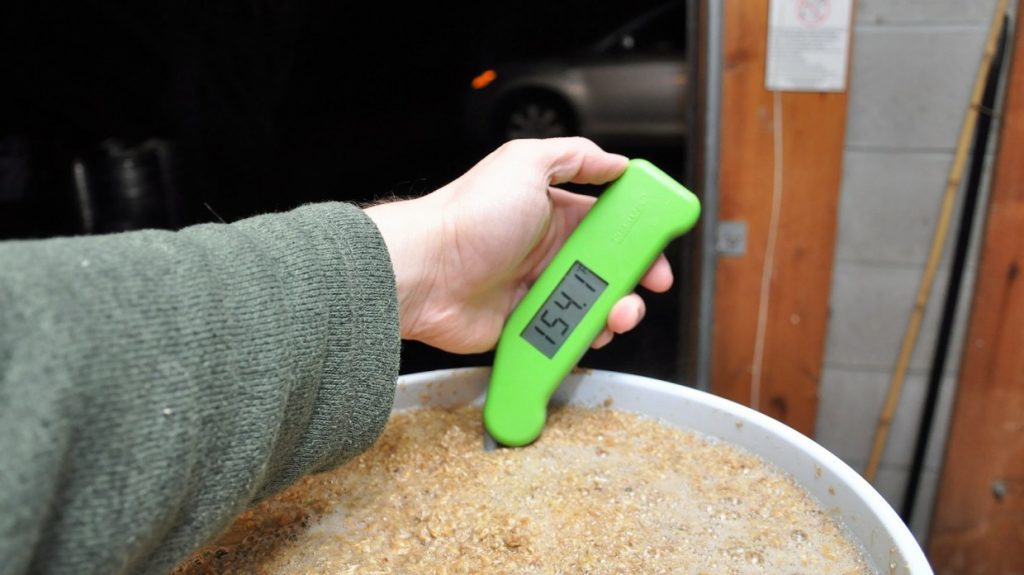
After a 45 minute rest, I collected the entire volume of sweet wort in a single kettle where it was brought to a boil, hops added per the recipe.
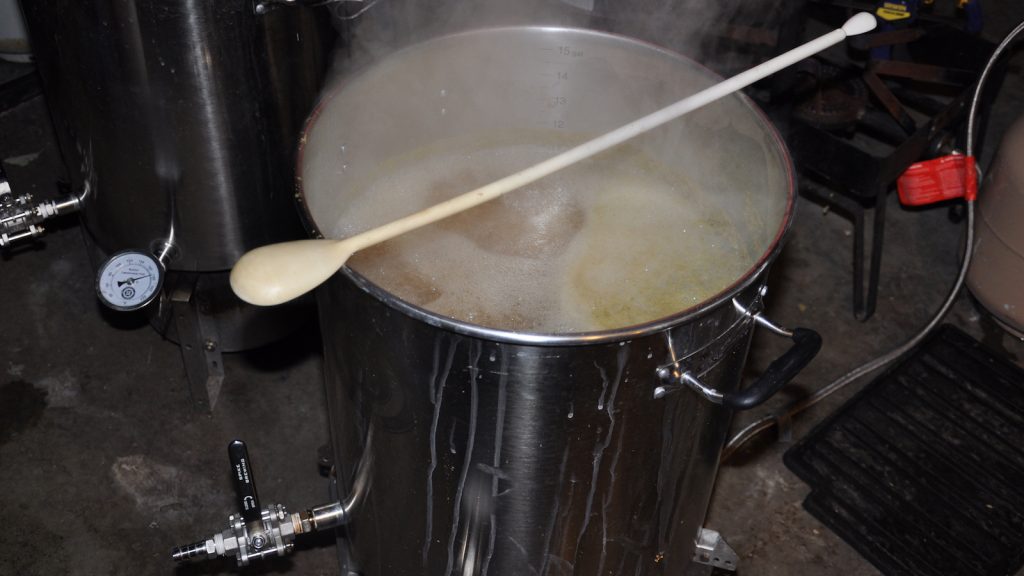
A hydrometer measurement confirmed I hit my target OG.
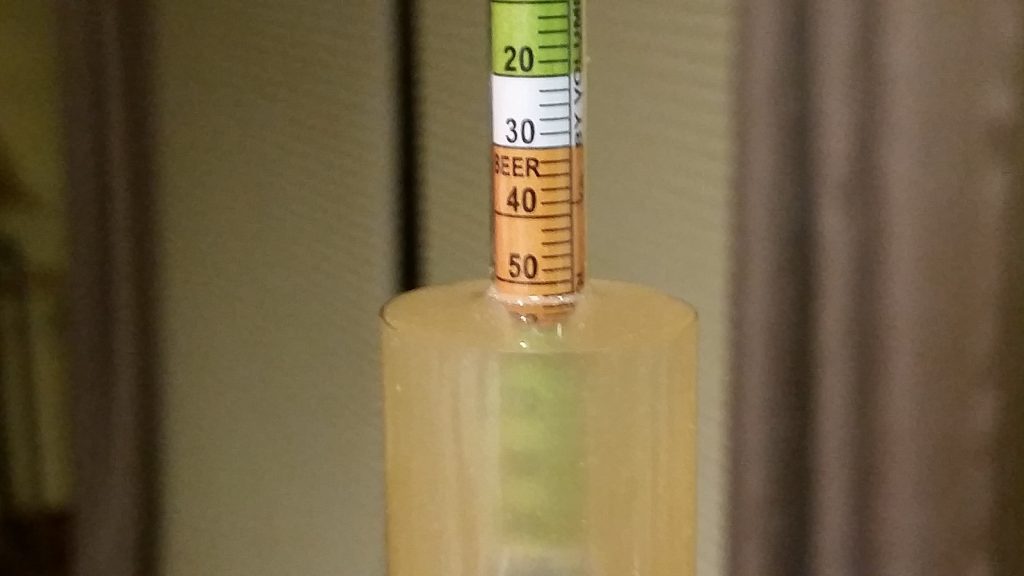
Following a 60 minute boil, I quickly chilled the wort before transferring 5.5 gallons/21 liters to separate plastic fermentation buckets.
I placed the wort filled buckets next to each other in my spot in my garage that maintains a steady 66˚F/19˚C during that particular time of year. After pitching equal amounts of the Saccharomyces starter into each wort, I poured half of the microbe blend into the combined pitch batch.
Both beers were fermenting actively the following day. I let them roll for 2 weeks, a point at which airlock activity was all but absent, before pitching the microbe blend into the staggered pitch beer. The beers were left alone for another 4 weeks before I snuck a peak that revealed both had developed pellicles, though they did look a little different.

I took pH readings at this point that showed a fairly large disparity between the beers, surprisingly opposite of my expectation.
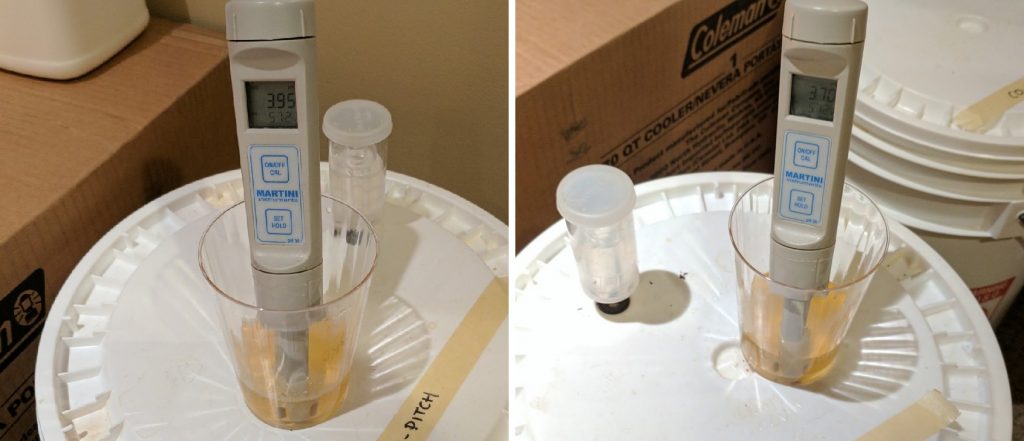
After 2 more weeks, 8 since brew day, I took hydrometer readings showing the FG of the beers was just barely different.
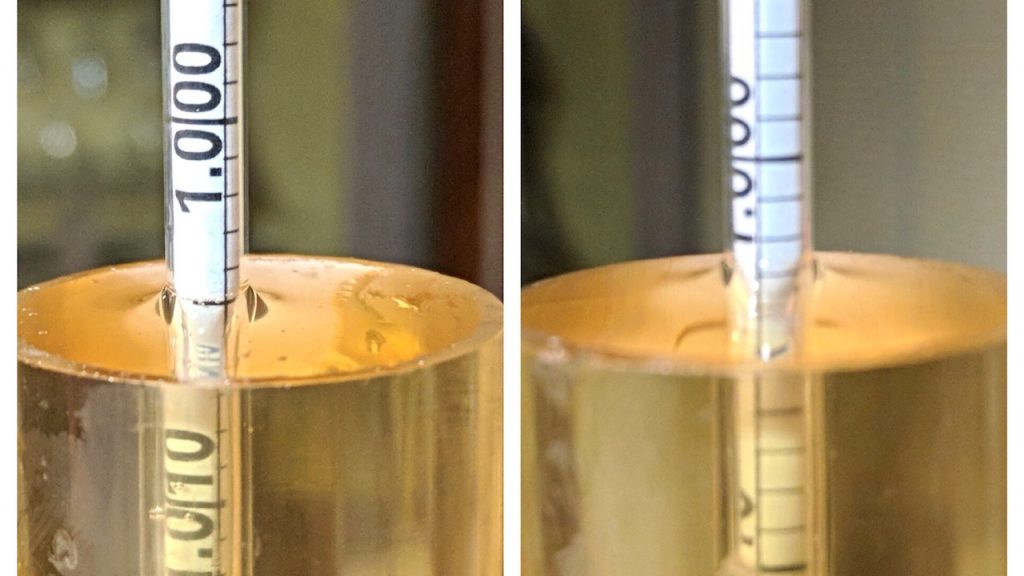
At this point, I pulled off 2 liters of each beer, chilled them down, and carbonated them using a carbonator cap in preparation for the first round of data collection. I then set the beers aside to mature over time, a fairly common approach when making sour beer, returning to them several months later. A set of measurements taken at this time showed both beers continued to acidify, though the staggered pitch batch maintained its lower pH.
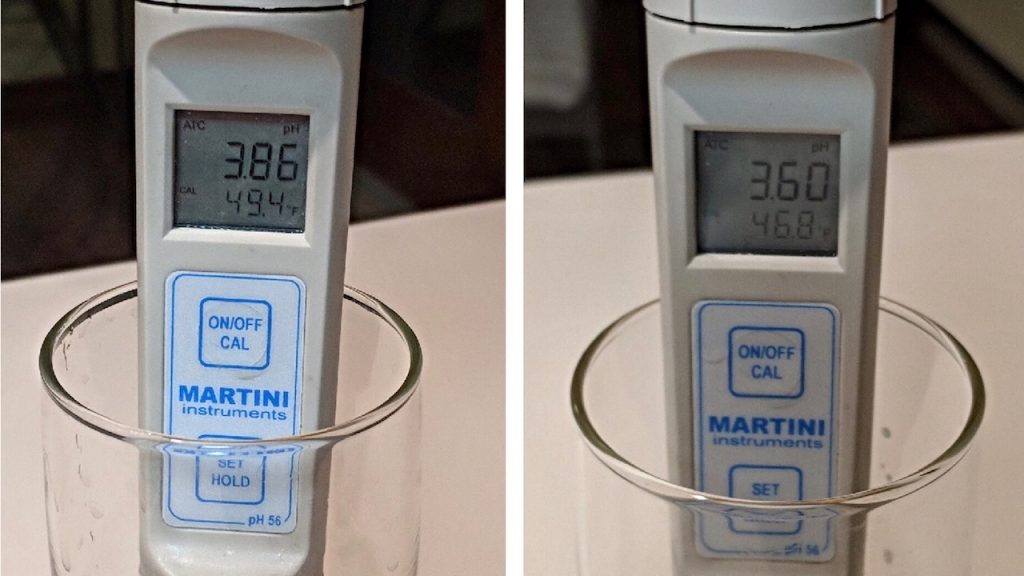
The beers were then kegged and placed in my keezer to condition and carbonate for a couple weeks before I presented them to a second panel of blind participants.
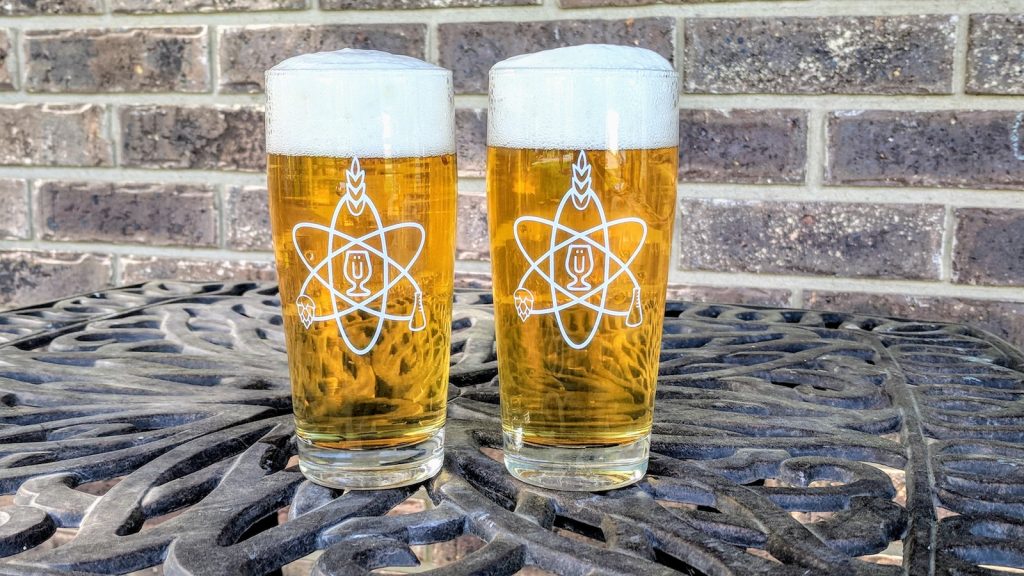
| RESULTS |
Since mixed fermentation beers are often aged over time to allow for the development of certain characteristics, two sets of data were collected 10 months apart. In both, participants with varying levels of experience were served 1 sample of the combined pitch beer and 2 samples of the staggered pitch beer in different colored opaque cups then asked to identify the unique sample.
The first trial occurred at Dancing Gnome brewery during a TRASH club meeting approximately 8 weeks after brew day and included 15 participants. At this sample size, 9 tasters (p<0.05) would have needed to make the correct identification in order to achieve statistical significance, though 10 did (p=0.009), indicating participants could reliably distinguish a Golden Sour pitched with all microbes combined from one fermented first with Saccharomyces then pitched with other microbes.
A total of 21 people participated in the second trial 10 months later, which would require 12 (p<0.05) accurate selections to indicate significance. This time, 15 tasters (p=0.0004) picked the unique sample, both corroborating the data from the earlier trial and suggesting age, at the very least, has minimal impact on reducing any disparities between combined and staggered pitched mixed fermentation beers.
While there are downsides to data aggregation, given these were technically the same beer and both trials were significant, we opted to share the combined results. In all, there were 36 participants, which would require 18 (p<0.05) accurate selections to reach significance, while a total of 25 (p=0.00001) identified the odd-beer-out.
For the first trial, 5 of the 10 participants who made the accurate selection on the triangle test reported preferring the combined pitch beer, 1 liked the staggered pitch beer more, and 4 had no preference despite perceiving a difference. Curiously, only 3 of the 15 participants in the later trial preferred the combined pitch beer while 11 liked the staggered pitch sample more; only 1 endorsed having no preference despite tasting a difference.
| DISCUSSION |
A common concern when it comes to fermenting with microbial blends is that, when pitched at the same time, one organism will lead the pack, making outcome prediction difficult and potentially producing a beer that’s characteristically out of balance. A popular method for assuaging such worries when making mixed fermentation beers involves pitching a pure Saccharomyces strain first, letting it do its work, then adding other microbes.
Having used both methods numerous times, the fact participants could reliably tell apart the combined pitch beer from the staggered pitch beer wasn’t shocking to me, as it confirmed my suspicions. In my experience, pitching all of the microbes at the same time seems to produce a fruity character while staggered pitching emphasizes more phenols. There’s no way to know what it was about these beers that made them distinguishable to participants, but to my palate, they aligned with my expectations.
While preference is very subjective, I thought it was interesting that ratings on this scale flipped after 10 months of aging, with the majority preferring the combined pitch sample in the early trial while most liked the staggered pitch beer in the later trial. To extrapolate from this that one approach is necessarily better or worse than the other would be foolish. That said, this data made me wonder if age has a qualitatively different impact on beers made using either method.
Prior to this xBmt, I’d pretty much settled on combined pitching as my method of choice, and I have no plans to change that based on these results. It’s not that I didn’t enjoy the staggered pitch beer, it was totally fine, I just preferred the fruitiness I picked up in the combined pitch beer more. For the brewer who hasn’t been achieving the characteristics they desire using one method, it may be worthwhile to try something new.
If you have any thoughts about this xBmt, please do not hesitate to share in the comments section below!
Support Brülosophy In Style!
All designs are available in various colors and sizes on Amazon!
Follow Brülosophy on:
FACEBOOK | TWITTER | INSTAGRAM
If you enjoy this stuff and feel compelled to support Brulosophy.com, please check out the Support page for details on how you can very easily do so. Thanks!




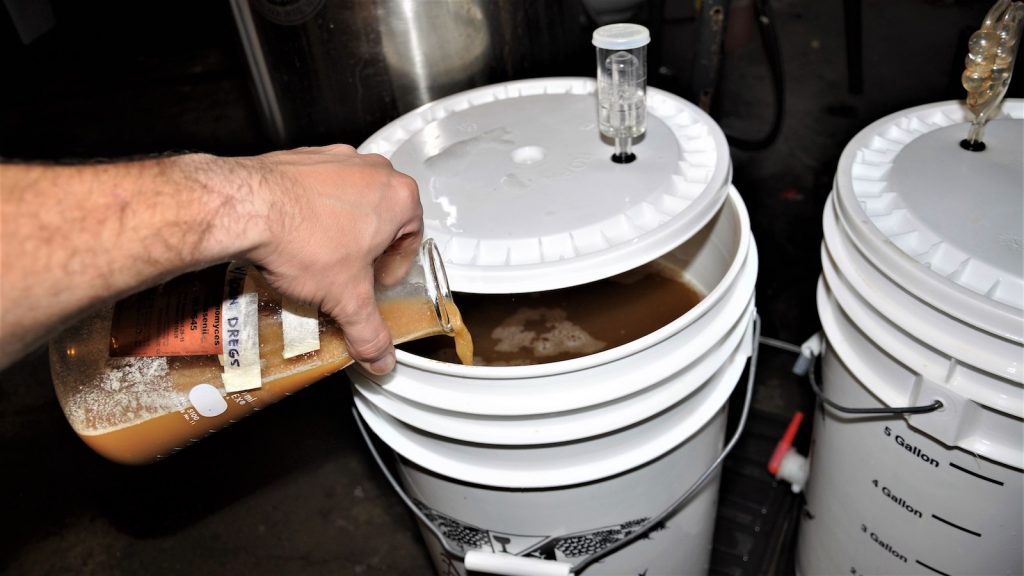










22 thoughts on “exBEERiment | Combined vs. Staggered Microbe Pitch In A Mixed-Fermentation Sour Beer”
YES! SOUR BEER EXBERRIMENTS!!
Very interesting thanks
YUP! I’m also super stoked to see more mixed fermentation Exbeeriments! Great xbmt! Cheers
Appreciate your enthusiasm! They have a long feedback loop. We hope to do more.
I’m a combined pitch guy too because I feel as though they come into their own quicker (and honestly, it makes the process simpler too) and love seeing Brulosophy doing mixed fermentation Xbmts too!
I’d love to see the same type of thing with pitching just Brett and Sach together versus staggered. Cheers!
I’ve been messing around with staggered pitching in the opposite direction. Pitch your bugs first and give them a headstart before your sacch comes in and bogarts all the sugar. This is with the intent of making saisons more tart. Very weird that you got lower pH on the opposite stagger method. Maybe Brett being more stressed created more acetic acid?
Interesting idea aaron – have you ever pitched only brett and lacto? It’s a go to of mine for more sour beers.
I’ve primaried with just Brett and Pedio and liked those results, too. It works out nicely because the Brett is there to clean up after the pedio.
You mentioned having a preference at the end, but if I’m not mistaken, you don’t provide much of a sensory analysis yourself. I usually enjoy reading those segments as they have a bit more detail
This does not have to do with the xbmt so much but I have a question regarding the hydrometer readings. I noticed that your reading the hydrometers at the top of the meniscus. Isn’t it supposed to be read at the bottom of the meniscus? Your OG is 1.054 w/o temp correction when I read it.
Caleb,
It will depend on the hydrometer and how it’s calibrated. Best to just use the directions for your specific hydrometer. For example, just as some are calibrated to indicate 1.000 at 60 degrees Fahrenheit, some at 65, others at 68 F; similarly, while most are cal’d to the bottom of the meniscus, there are certainly some that are top of the meniscus. I don’t know what everyone else’s directions say, but my hydrometer says to read top of meniscus.
My take is that the LAB may acidify more aggressively as a result of stress from competitive factors. However I would also like greater research initiated into this PFM idea. Fascinating!
Great exbeeriment! Granted, the same wort fermented with the same mixed culture in the same manner at the same time in the same location – split between 2 carboys – might very well end up being significantly different via a tasting panel test.
Nice experiment!
All bugs got oxygen in the combined, but only sacc in the staggered, right?
Did you/ tasters get more acetic in the combined?
Ricardo, O2 only during initial yeast pitch. No (intentional) additional O2 upon the staggered pitch.
Kudos on the dedication required for a (nearly) year-long exbeeriment! I don’t have that kind of patience…or enough patience for sours in general. Might the change in preference over time be due to different groups of tasters having different preferences? Were the groups of participants completely distinct for both trials or were there overlaps?
CD,
Because of the close-knit nature of Pittsburgh Homebrew clubs, there’s a lot of overlap between at least two or three clubs, I assume there was a good amount of people who attended both. We don’t typically track people’s performance.
I should also state, neither group knew the variable, and due to the 10 month separation, even the few who did participated previously could not remember the previous trial. When asked I had to remind them it was at Dancing Gnome nearly a year ago.
Man… this one really blows my mind. Sours to me really emphasize one thing: the are literally alive. They change with time and with the tiniest of variables.
Love it! Great Exbeeriment!
Great article. If there were ever a realm of beer that needs to be illuminated brulosophy style, it would be this “dark” realm. I agree with other commenters about doing more brett/sac and maybe even 100% brett stuff. I’m not familiar with PFM but I think this was the meaning you were going for?
https://www.urbandictionary.com/define.php?term=PFM
More like this – http://m.acronymsandslang.com/definition/6286081/PFM-meaning.html
Hi! at some point did you transfer the beer to another container, to avoid possible autolysis?
Nope. I do not mind some minor autolysis for long aged mixed ferm beers.